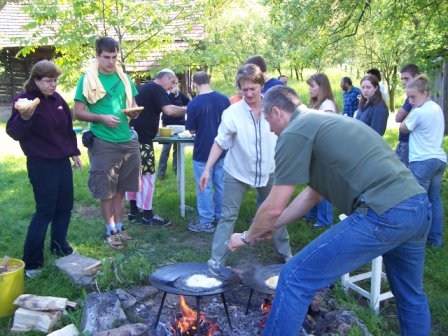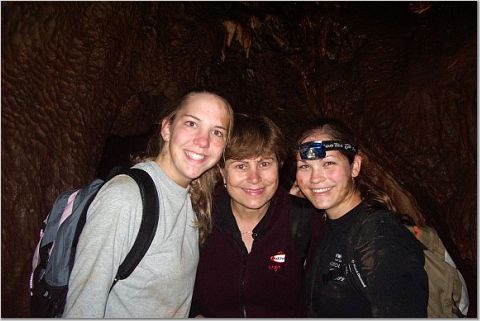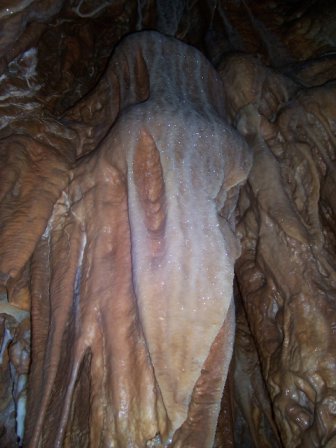|
Sixth Day
After a crazy night by the campfire, we woke up, ate a strange breakfast, jumped in the caving van and started our day.
The breakfast was the most interesting one I have ever had. Miklos, one of Dr. Anna's friend is cooking langos which consisted of fried bread covered with sour cream and topped with cheese and fresh garlic.
After breakfast We took a tour in the Baradla Cave, which is the longest cave in Hungary lead by Miklos Szabo. The group was very excited to go on a tour of this cave two weeks before the doors opened to the public. They just finished a major remodeling and we happened to be the first visitors before opening it again. We had a great time there. The baradla cave has been a World heritage site since 1995. Our tour was 2.3 km long. We descended to the cave through a man made tunnel and then followed the course of the Styx Stream. We stopped to admire the “Astronomical Telescope”, which is the tallest stalagmite not only in the Baradla cave but in Hungary. We also stopped in the so-called “Giants’ Hall”, which is the biggest room in the cave system. We left the cave at the Josvafo entrance near the Tengerszem hotel. Miki showed us the electrical miracle they have made during the remodelling.
(http://www.anp.hu/anp/default.asp)
The Aggtelek National Park lies mostly on limestone formed in shallow seas during the Triassic, about 210-240 million years ago. This type of bedrock is particularly prone to karstification. The 5 million years of karst development since the end of Tertiary has resulted in a typical temperate zone middle elevation karst surface. The karst landscape is dominated by extensive karst plateaus which average altitude of only 600 m is unique in Europe. They are dotted with hundreds of shallow depressions called dolines and more compound forms like karst valleys with rows of dolines and uvalas. Other characteristic landscape features are the blind valleys at the end of karst areas with permanent or temporary water courses disappearing in sinkholes, called "sly" holes or devilīs hles by local people. The water that goes under the ground hollows the underground world. Around 262 caves are registered in the national park. (http://www.anp.hu/anp/default.asp)
(http://www.anp.hu/anp/default.asp)
Entrance at Voros to Baradla
The limestone Baradla
The main route in the Baradla along the Styx river
Look what we found in the cave
Off the beaten path After the cave
Being silly as always: Kristen, Szabo Miki, Dr. Anna Varga Geza and Hayley
Geology path around the Aggtelek-Josvafo karst area After the cave, we had a little time so we walked along the Tahonya-Kuriszlan geology path. We saw some very interesting educational observations along the path. Could stop and observe the disappearing stream surface again thorugh a spring, saw sinkholes. We also could practice climbing through a hanging bridge.
After a crazy ride over a river and through the woods, we arrived to our next challenge the Vass Imre Cave. This cave is not built for the public, basically it was a wild cave. The first section of this cave was lit up and navigable by anybody who could find it but eventually the lights disappeared and we had to pull out our headlamps. Sections of this cave had around two feet of water in it and the only way to get through was to get wet (or walk on the walls). The half of the group that did not care about getting their shoes dirty continued through the cave with Dr. Anna and her friend who was an experienced caver, while the rest of the group returned to the entrance. We unfortunately were forced to turn around and head back to the rest of the group because the lower rooms of the cave were flooded with water from the previous days of rain.
The Vass Imre cave was formed from in the 230 million-year-old Middle Triassic limestone. The start of its formation can, on the basis of geological data, be put at around 2 million years ago. The waters of the streams got into the system of cracks and, by dissolving and eroding the limestone, slowly widened the crevices and formed the present passages. The dripping water deposited its lime content, forming the stalactites and stalagmites of various size, colour and shape decorating the passages. These formations inspired the imaginations of discoverers and visitors, who gave some of the formations special names like Dragons Head, Tiger, Mother in Laws Tongue, the Hall of Columns and the Hall of Giants. (http://www.hungary.com/servlet/page?_pageid=7064,6177&_dad=portal30&_schema=PORTAL30
Dr. Anna in the Vass Imre Cave and her friend, Istvan walking on the walls.
This page has been viewed
times since July 25 2005.
|

























